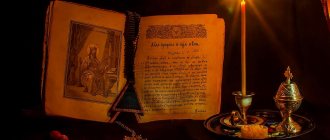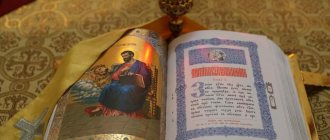"Save me, God!".
Thank you for visiting our website, before you start studying the information, please subscribe to our Orthodox community on Instagram, Lord, Save and Preserve † - https://www.instagram.com/spasi.gospodi/. The community has more than 60,000 subscribers. There are many of us like-minded people and we are growing quickly, we post prayers, sayings of saints, prayer requests, and timely post useful information about holidays and Orthodox events... Subscribe. Guardian Angel to you!
A person close to the Lord constantly performs the same ritual, but does not think about its meaning. While in church or at home, all believers are baptized, but few people know how to properly baptize Orthodox Christians. Before we talk about the rules of baptism, we should remember a little history and find out where this tradition came from and what it means.
Five or four?
In Catholicism, double-fingering is practiced, just like among the Old Believers of Tsarist Russia, the schismatics.
In this case, two fingers also mean the dual essence of the Savior-God-Man. It is interesting how making the sign of the cross with the palm of your hand is interpreted. The five fingers of the praying person’s hand symbolize the wounds of Christ: four from nails and one from the spear of a Roman soldier who pierced the side of the Savior. However, it is worth noting that in the Catholic tradition, Jesus Christ was crucified with three nails: two in the area of the hands, one in the crossed legs, a total of three, that is, we are observing a clear contradiction in the interpretation of symbols in Catholicism. However, the main difference is still not considered to be the position of the fingers of the person praying. There is an opinion that if the sign of the cross is performed from right to left, as in Orthodoxy, then this means something coming from God to man. In other words, the person praying, as it were, blesses himself by making the sign of the cross.
If you cross yourself from left to right, as the vast majority of Catholics do, then this has the opposite meaning: a person turns to God; for Catholics, communication with God is important
It is traditional in Christian culture that the left side is the side of the Devil, that is, by performing a sign from left to right, you renounce Satan and his works, moving to the side of the light. In Orthodoxy, the concept of understanding the left and right sides is similar, but the reverse order, from the right shoulder to the left, symbolizes the victory of the divine, good over evil, life over death: “Christ rose from the dead, trampling down death by death and giving life to those in the tombs!” - sung in the Easter Troparion.
Which hand and how to be baptized correctly
Which hand is the correct one to cross yourself and how to cross yourself correctly - from left to right or from right to left? How to fold your fingers correctly? Why do you need to be baptized and is it necessary to do this before entering the temple?
The essence of the sign of the cross, why is it necessary to be baptized?
The sign of the cross for a believer combines several essences: religious, spiritual-mystical and psychological.
The religious essence is that by making the sign of the cross, a person shows that he is a Christian and lives with Christ; that he is part of the Christian community, appreciates its traditions and values them. That he remembers and keeps in his heart the entire earthly life of Christ - from His first to his last day - and tries to the best of his ability to live up to it. That he honors and tries to live according to the commandments that were given by Christ.
The spiritual and mystical essence lies in the fact that the sign of the cross itself has life-giving power - protecting the one who is baptized and sanctifying him.
The cross is a spiritual image that a person puts on himself, “overshadows” himself with it - making himself, according to the degree of his faith, similar to Christ.
Therefore, Christians have a reverent attitude toward the sign of the cross and they try to be baptized not hastily, “fusily,” but with accountability.
Moreover, when it is said that the sign of the cross has a certain “mystical” essence, it does not mean that the cross is a “mathematical” formula - such as the Indian mantra, or the rituals of magicians - which begins to “act” from the simple repetition of a set of actions or words. In a way inexplicable to human understanding, the cross sanctifies everyone who is baptized, but at the same time, everyone is “rewarded according to his faith”...
The sign of the cross is a prayer and the attitude towards it should be appropriate.
The emotional and psychological essence of the sign of the cross lies in the fact that a believer unconsciously begins to cross himself when he is “used to it” (at certain moments of the service), or at those moments when he wants to collect himself internally (before an important matter, before a secret step), or simply when he experiences psychological fear of something. Or vice versa - we are filled with joy and gratitude to God. Then the hand “begins to be baptized itself.”
With what hand and how correctly should Orthodox Christians be baptized?
In the Orthodox tradition, you need to be baptized with your right hand - regardless of whether you are right-handed or left-handed.
The order is as follows: forehead - stomach - right - then left shoulder.
You can “shrink” the sign of the cross (not the stomach, but the chest) - for example, in situations where there are non-believers around, you want to cross yourself, but you try to do it “invisibly.”
The main thing is not to trivialize the cross “within yourself”, always remember its greatness, importance and strength
How to fold your fingers correctly
The Orthodox tradition says that the fingers should be folded like this: the thumb, middle and index fingers are brought together - this symbolizes the Holy Trinity - and the ring finger and little finger are pressed against the palm.
Is it possible to cross yourself in some other way or, for example, with two fingers or from left to right? No - in the Orthodox Church it is customary to cross yourself with three fingers from right to left, and you need to do it this way - without reasoning.
A page from the pre-revolutionary book “The Law of God,” which tells about how to correctly fold your fingers when making the sign of the cross, and what all this symbolizes.
Do I need to be baptized before entering a temple or while passing through a temple?
It is customary to cross oneself when entering a temple. For a person who is just getting acquainted with religion, this may seem like an artificial rule (sort of like a “must”), but over time it becomes natural and, even, a need - to “gather” internally, to overshadow oneself with Christ’s symbol and power, to pay tribute to the temple in which the sacraments are performed.
see also: How to behave correctly in church?
As for the situation when you just see a temple and pass by it, then a person must rely on his feelings and there are no rules. There are people who overshadow themselves with a sign every time they see the domes of the temple. There are those who do not do this, but at the same time in life they will be no less an example of a Christian.
Read this and other posts in our group on VKontakte
And also on Facebook!
Join us!
Why do people cross themselves when they pass by a temple or monastery? Is it necessary to be baptized?
According to the rules of piety, an Orthodox Christian, passing by a temple, must stop, reverently sign himself with the sign of the cross and bow to the temple of God, thereby giving the glory of God to our Lord Jesus Christ, Who for us and our salvation came down from heaven, was incarnated by the Holy Spirit and the Virgin Mary and became human. He was crucified on the Cross for our sins. Buried, Resurrected and Ascended into heaven and sat down at the right hand of the Heavenly Father, so that at His second coming in glory with all the Saints and Angels, He would judge everyone according to their deeds. That is, by his worship, a Christian publicly confesses the faith of the Orthodox Church in our Lord and Savior Jesus Christ. And about those who are ashamed of such a confession, the Lord said: “Whoever is ashamed of Me and My words in this adulterous and sinful generation, the Son of Man will also be ashamed of him when he comes in the glory of His Father with the holy Angels” (Mark 8:38).
We are called Christians
because we believe in God as the Son of God Himself, our Lord Jesus Christ,
.
Jesus Christ not only taught us to correctly believe in God, but also saved us from the power of sin and eternal death
.
The Son of God, Jesus Christ, out of love for us sinners, came down from heaven and, as a simple man, suffered in our place for our sins, was crucified, and died on the cross
We advise you to study Congratulations on the Trinity in prose
and on the third day he rose again
.
So the sinless Son of God by His cross
(that is, by suffering and death on the cross for the sins of all people, the whole world) he defeated not only sin, but also death itself - he rose from the dead
, and made the cross the instrument of His victory over sin and death.
As the conqueror of death - resurrected on the third day - He saved us from eternal death. He will resurrect all of us who have died when the last day of the world comes, He will resurrect us for a joyful, eternal life with God.
When to make the sign of the cross
It is necessary to be baptized at the beginning of any prayer, during its recitation, and also after the end of the prayer process. If we approach a holy place, for example, a temple, we also need to sign ourselves with the sign of the cross. They do this at the entrance to the church, when kissing holy relics, icons or crosses.
Christians are required to be baptized at the beginning of every task and after it is completed. They also make the sign of the cross before the start of any meal and after it ends, when entering and leaving the house, in sorrow and in joy, and in the event of approaching danger. Every new thing is baptized before they begin to use it.
Historical places associated with the adoption of Christianity in Armenia
Much of the above took place in what is now Armenian territory. Those interested can visit the sites of these historical events.
- Khor Virap, the monastery where Gregory the Illuminator was imprisoned. Here anyone can go down to the dungeon where Grigor was kept;
- Church of St. Hripsime, where Hripsime, one of the 40 virgins whom the king wanted as his wife, was tortured and killed;
- Church of St. Gayane, under which are the bodies of the remaining virgins killed by the king;
- Etchmiadzin Monastery, built by King Trdat and Grigor in 303 on the site where Christ appeared to him in a dream of Gregory the Illuminator.
As we see, Christianity was adopted by Armenians during the life of Christ. Confirmation of this is easy to find in our cultural and artistic monuments. The adoption of Christianity as the state religion in 301 was a confirmation of the faith of our people by its government.
How other Christians are baptized
It is worth noting that not all modern Christians are baptized with three fingers - the way Orthodox Christians are baptized. For example, Catholics make the sign of the cross with all five fingers. This refers to the five plagues inflicted on Jesus Christ when he was crucified on the Cross.
Protestants generally consider the veneration of the Cross unacceptable, since they perceive it as an instrument of death and desecration of the Lord. However, let us remember the words of the Apostle Paul:
An interesting fact is that modern Egyptian Christians - Copts - do not wear a cross. They imprint a cross on themselves in the form of a tattoo on their wrist. According to one version, this tradition dates back to the 7th century, when the Egyptian authorities banned the wearing of a cross. Then Christians began to paint the sign of the cross on their bodies as a symbol of their religion. Today, such a sign is also applied in case of sudden death. So that, for example, after a car accident, an Egyptian Christian does not have to be buried according to Muslim rites.
The history of the sign of the cross
The imposition of a cross on oneself began in the first centuries of Christianity. It is known that even in apostolic times, followers of Christ made the mark of a cross on their bodies. True, only with one finger. By the 4th century, the so-called “wide cross” known to us appeared. With him, a cross was made over the head, stomach and shoulders, but they still did it with one finger. During this period, the custom of baptizing not only oneself arose. Since then, the cross has been used to bless household items during everyday activities.
In the 9th century, the heresy of Monophysitism began to spread. This is a doctrine that recognized in Jesus Christ the only Divine nature. His humanity was denied. To confirm their views, they cited the sign of the cross. Therefore, Orthodox Christians began to use two fingers to apply a cross to themselves. This was a sign of the symbolic confession of the two natures of the Lord Jesus Christ.
In the 12th century, the need arose to introduce differences between Orthodox Christians and followers of the heretical movement - Nestorianism. This is a heresy that denied the Divine nature of Christ and recognized Him as a man in whom God lived. It was then that the Greek Orthodox Churches determined how Orthodox Christians were baptized. It was decided to use the familiar three-fingered sign of the cross, signifying the veneration of the Holy Trinity.
In Rus', triplicate took root only in the 17th century after the church reforms of Patriarch Nikon. During the same period, the so-called “nominal finger formation” appeared. This is a special arrangement of fingers that is used only by clergy to bless those praying. The fingers are folded in such a way that the name Jesus Christ is formed. Two fingers are folded in the form of a cross, two - in the form of the letter “X”, the little finger extended upward means the letter “I”.
Why are they baptized and how to be baptized correctly at the grave of the deceased?
It is necessary to come to the grave and read an enhanced prayer. It is worth asking forgiveness from the deceased. If you wish, you can read an akathist about the repose of the departed. Next, clean up the grave and remember the deceased with good words. No need to drink at the grave and leave vodka with bread. These are remnants of paganism. In addition, because of such “gifts”, homeless people often trample on the grave and disturb the deceased. Nowadays no one leaves such “gifts”. Regarding sweets and cookies on memorial days, it is also better to distribute them to friends and ask them to remember them. If you leave a package on a grave, homeless people will trample there.
We recommend studying Psalm 93
Why are they baptized and how to be baptized correctly at the grave of the deceased?
What you can’t ask God for in prayer
You can ask God for almost anything in your prayer. You will definitely be given this if the benefits you ask for are useful for your soul, spiritual development and the fulfillment of your mission on Earth. The only exception is a request for punishment for one’s enemy(s). Instead of punishment, pray for the salvation of the enemy’s soul, ask the Lord to guide that person on the true path. And regarding revenge, Scripture says: “Vengeance is mine, and I will repay it.” That is, vengeance is the work of God, not man. Higher powers will put everything in its place.
How to be baptized and how many times
The Charter of the Russian Church regulates in a certain way the making of the sign of the cross. It can be performed with a bow (from the waist or to the ground) or without a bow. But there is no petty regulation in the Charter of how much and when to be baptized in different situations, so almost everything is determined by established custom.
Before entering a temple or church
When entering a church or monastery courtyard, they make one sign of the cross with a bow from the waist. Upon entering the church, the believer crosses himself three times in honor of the Holy Trinity. After each sign of the cross, a bow is made.
In front of the icon
As a rule, people cross themselves in front of the icon three times - twice before applying it to the image, once when moving away from the icon. Sometimes you can come across advice to be baptized in front of an icon only once, then light a candle and say a prayer. You can often see that believers cross themselves twice: they cross themselves and bow when approaching the image, venerate the icon, then bow and cross themselves again. The practice of church life shows that the number of signs of the cross in front of an icon is determined more by local tradition than by the Charter.
During a church service or liturgy
The rules for making the sign of the cross during the service are regulated in the most detail. According to the Charter, making the sign of the cross without bowing is performed:
- before and after reading the Holy Scriptures;
- while singing the Creed;
- with the blessing of the priest completing the service (the so-called “dismissal”).
One should be baptized with a bow from the waist:
- with petitions at litanies;
- during the priest's most important prayers.
There are many rules about making the sign of the cross during worship.
For those who are not very experienced, it is best to be baptized when the priests do it, or simply pay attention when other people in the temple are baptized
While praying at home
During home prayer rules, people usually cross themselves at the beginning and end of the prayer. The same must be done before reading the Holy Scriptures, as well as after finishing reading.
Before entering the cemetery
Priests recommend that when entering a cemetery, you read “Rest with the Saints...” or another short funeral prayer. A pious feeling, respect for the resting place of bodies before the General Resurrection, of course, requires that one sign oneself with the cross.
At the grave of the deceased
There is no special regulation on how and how many times to be baptized at the grave of the deceased. Signing oneself with a cross is done on the approach to the grave, before and after prayer, and before leaving.
Driving or passing by a church or temple
A pious Christian crosses himself while passing or driving past a church. There are different opinions about the necessity of such an action. Many people say that it all depends on motivation: it is reasonable to cross yourself if there is an internal need to do so.
At the crossroads
There are various beliefs about crossroads. All of them are pagan and are associated with the belief in the magic of road crossings. From a Christian point of view, there is no point in making the sign of the cross at crossroads.
In a sitting position
In case of extreme fatigue or illness, while sitting you can not only be baptized, but also perform a prayer rule. In churches you can see many sick and elderly people praying while sitting throughout the service.
child
The blessing of the cross attracts God's mercy and help to the child. When making the sign of the cross over a child (as well as another person in general who is being blessed), baptism is performed from left to right. Thus, the person being blessed should receive a “right” cross.
In the ice hole for Epiphany
Epiphany bathing is a pious tradition. A believer plunging into an ice hole is baptized three times in honor of the Holy Trinity. But there are no special rules for making the sign of the cross during Epiphany bathing.
Is it possible not to be baptized, but to be a believer?
Yes, the main thing is that you have Faith inside you. Therefore, you don’t have to be baptized, but still believe in God. But still, it is generally accepted that a believer should attend church and be baptized.
Is it possible not to be baptized, but to be a believer?
As you can see, it is better to be a believer and pray in your own way than to go to church and do everything automatically. Faith must live within you.
How does the sacrament work?
During the sacrament, the godparents hold the baby. Parents watch the process. The girl is held in the arms of the godfather, and the boy is held by the godmother. After the immersion in the font takes place, the godparents change places. Until the end of the sacrament, the woman now holds the girl, and the man holds his godson. If a baby is baptized, the priest immerses him in the font 3 times. At the same time, prayers are said. The water in the font is warm. However, if you are worried, then it is better to find a temple where baptism takes place in a separate room, and not in the temple itself.
The priest also anoints the child with myrrh. Through this action, the gifts of the Holy Spirit are transmitted to a person. After baptism, the child needs to receive communion as soon as possible. After the sacrament, the priest or godparents walk around the font 3 times with the child in their arms. The boy is also brought to the altar, and the girl is bowed before the icon of the Mother of God. After this, with a cross-shaped movement, the priest cuts off a couple of curls from the child’s head. This is his first sacrifice of thanksgiving to God. The sacrament itself takes 1 hour.
Choose a temple that you like, where the priests and staff are friendly. Christenings are celebrated at home. Krupenik with berries or fruits, as well as sweet pies, are prepared for the festive table.
Rules for prayers for healing
It just so happens that many come to God only after they get sick. As they say, “until the thunder strikes, a man will not cross himself.” This is the essence of human nature. That’s why God tests us sinners by sending us illnesses and life problems. God's goal is to save not the body, but the soul of man.
If you or your family are sick, ask for health not only from the holy healers we mentioned above. Pray for the health of Saint Xenia of St. Petersburg, Matrona of Moscow, Nicholas the Wonderworker. And, of course, ask for the health of Jesus Christ and the Mother of God. Belief in the effectiveness of prayer is required! As the Scripture says: “according to your faith it will be given to you.”
How Greek Catholics and Jews are baptized
Speaking about Catholics, it is necessary to note the fact that there are Roman Catholics and Greek Catholics. Both of them have something in common and something different.
- Greek Catholics recognize the Pope as the visible head of the Church and consider themselves to be part of the Roman Catholic Church.
- It is worth saying that Greek Catholics have many things in common with Orthodox Christians, including the method of drawing the cross.
- They cross themselves with their right hand, and with their hand they draw the cross in this way: from top to bottom, from right to left.
- Also, Greek Catholics and Orthodox Christians have a common finger shape. When baptizing, the fingers are folded in this way: the first 3 fingers are joined together, and the little finger and ring finger are pressed to the palm.
- Representatives of this movement living in Western Ukraine often perform other movements during baptism. For example, a hand movement is made that marks the pierced side of Christ.
- If we take Roman Catholics for comparison, they apply the sign of the cross differently. The movements proceed from the head to the belly, and then from the left shoulder to the right. In this case, the fingers fold differently. This is both a two-finger and a three-finger addition.
Now let's talk about the Jews:
Let's start with the fact that the traditional religion professed by this people is Judaism. The words “Jew” and “Jew” are very similar and today have the same meaning in many languages of the world. However, in our country it is generally accepted that “Jew” is still a nationality, and “Jew” is a professed religion. Before answering the question “How are Jews baptized?” Let’s talk a little about what the “cross” symbol itself means to them. By the way, it would be more appropriate to ask the question “Are Jews baptized at all?” So, in ancient times, the cross was associated among the Jews with fear, punishment and death itself. While for Christians, the cross is the main symbol that can protect and protect from misfortune and troubles. Today, Jews recognize the holy cross, but they attach a slightly different meaning to it. For them, this is a symbol of the rebirth of the Savior
By and large, the cross does not carry such importance (as it does for Christians), therefore, accordingly, there is no need to impose a sign on oneself. This suggests the conclusion that Jews are not baptized at all.
We advise you to study Psalm of David 38
When is Orthodox baptism performed?
Baptism is a sacrament after which a person becomes a full member of the Church. As a rule, a baby is baptized 40 days after birth. There may be a deviation of a couple of days. It is believed that during this period the baby will get stronger and calmly endure the ceremony. Children under 3 months can more easily tolerate plunging their heads into the font, since at this age reflexes that hold their breath are still preserved. However, there are no strict rules. You can baptize your child whenever you see fit.
Baptism of a child is carried out once in a lifetime
40 days after birth, a prayer is also read over the woman, which symbolizes purification. It is believed that due to physiological characteristics, she cannot enter the temple before 40 days. Purification occurs before or after the child is baptized.
If the baby’s health is in danger and he is placed in intensive care, then the child can be baptized in the ward in which he is located. A priest is invited for this. In emergency situations, a mother or father can baptize the baby themselves.
For self-baptism you will need water. The fingers are dipped into the water and the child is baptized three times, saying the following words:
Servant of God (NAME) is baptized
In the name of the Father. Amen (we make the sign of the cross and sprinkle some water).
And the Son. Amen (we make the sign of the cross and sprinkle some water).
And the Holy Spirit. Amen (we make the sign of the cross and sprinkle some water).
Baptism is performed on any day, even on holidays. However, each church has its own routine. Therefore, it is better to clarify it in advance.
Prayer rules for every believer
It is advisable to pray twice a day - in the mornings and evenings, before going to bed. It is forbidden to pray purely mechanically, as if you were reciting spells in a language you do not understand. Say the words of the prayer “with feeling, sense, and arrangement.” Think about it: would you like an interlocutor who chatters something under his breath, but is far from you with his thoughts?
You need to pray according to special prayer books that are sold in the church. Searching for texts of prayers on Internet sites is highly discouraged: a prayer, “migrating” from one web resource to another, often changes, becomes non-canonical, and incorrect. Priests believe that rather than using such modified prayers, it is better to “speak” to God in your own words.
While reading prayers, a believer may experience feelings of tenderness and euphoria. Try to avoid such feelings - they can lead to vanity. Like, look how righteous I have become, almost a holy person. Although in reality everything may be exactly the opposite: from sins and stigma there is nowhere to put.
And further. The Holy Fathers also recommend praying before every meal and before new beginnings. Thus, a believer thanks the Lord for giving food and asks Him to help fulfill his plans.
Depending on the situation, the prayer is read aloud or silently. In Orthodoxy, they pray in front of icons - images of Jesus, the Mother of God, St. Nicholas the Pleasant and other saints.
What does a priest's blessing mean?
This means that God's help is being sent to you. The fingers of the blessing priest (other church employees - deacons and readers cannot bless, only priests and bishops) are folded in a special gesture of a nominal blessing, sending down grace and used from ancient times in the Orthodox Church to this day.
Before every important thing, you should ask for a blessing from the priest (for example, buying a car, buying an apartment, going on a trip, getting married, starting a new job). It is better if it is your confessor - a priest with whom you regularly confess (if you have one). If you have not yet confessed or received communion, but are thinking about it in connection with important events in your life, tell about it to any priest on duty in any church.
The same gesture is used on icons - usually Christ blesses with it.
- The meaning of the blessing gesture on the icon and in life is help in the name of Jesus Christ.
- The fingers of the priest’s right hand are folded, forming the monogram IC XC, where the straight index finger is the letter “I” of the Greek alphabet, the middle and little fingers are two letters “C”, and the letter “X” is formed by the crossed thumb and ring fingers.
How to pray in the evening
Orthodox prayer books contain not only morning, but also evening prayer rules. It is advisable to read all the prayers. But if you are very tired, it is permissible to “deviate from the instructions” and say only some of the prayers that you like best. Pray thoughtfully, with “soul.” Before going to bed, it is useful to say the following:
“Into Your hands, O Lord Jesus Christ, my God, I commend my spirit; You bless me, you have mercy on me and grant me eternal life. Amen".
What godparents must do before the sacrament of baptism
The future godparents, together with the baby's parents, agree on the place and time of baptism. Before the sacrament, you will need to undergo a public conversation, or “interview,” in the church where the baptism will take place. There may be several such conversations. They lay out the basics of the Orthodox faith, which every Christian needs to know.
Who exactly will buy a baptismal set, a pectoral cross and an icon does not make a fundamental difference. If godparents want to give a gift to their godson, they can bear part of the costs themselves.
More often they buy an icon in a church shop: for a boy - the Savior, for a girl - the Mother of God. You can choose any icon based on your desires, tastes and means. But it should be borne in mind that this icon will be with the godson all his life. In the old days, it was customary to bless a grown child for marriage with this icon.
When entering family life, the bride and groom each brought their own icon with them, and they formed the so-called “wedding couple” of icons. Based on this, it is better to buy not the smallest icon (on which you can barely see the image), but a slightly larger one (usually chosen approximately the size of a book) and in a frame. But, I repeat, there are no hard and fast rules here, and if you are very limited in funds, an expensive icon is not at all an end in itself.
In addition to the process itself and the baby on whom it will be performed, there are also spiritual mentors. You need to choose them responsibly. Basically, the procedure is almost the same, but there are some features of the baptism of a girl that godparents should know. Initially, it is worth figuring out who can become a recipient.
- constant prayer for the child;
- introduction to the church and explanation of the essence of faith;
- explanation of the rules and laws of God.
Who cannot be godparents:
- people who are in close relationships with each other or relatives (brother, sister, husband, wife);
- unbaptized;
- the child's parents;
- monks;
- minors;
- people with psychological problems or with the law;
- representatives of other faiths.
During the selection process, a couple of godparents are often taken, but for an important girl there is a godmother, so you can choose one representative. There are no restrictions on the number of pairs of receivers
Basically, in most churches, the clergy ask those who will take part in the process to come and confess before baptism. During the procedure, the priest may ask the godparents to read prayers during the girl’s baptism. The main ones that are worth knowing by heart are “Our Father” and “Creed”.
The godparents renounce the devil and are united with Christ instead of the godson, then the main stage of baptism begins - immersion in the font, symbolizing death and rebirth from water and the Holy Spirit.
When a boy is baptized, the godfather receives the godson from the baptismal font. Together with the godmother, he wipes the baby with a baptismal towel and helps dress him in a white shirt, the color of which denotes the purity and sinlessness of the newly baptized soul. The godfather holds a baby up to one year old in his arms. Children over two years old can stand in front of the receiver.
How should one be baptized correctly?
There are many facts confirming the power of the sign of the cross if it is performed reverently, slowly, and decorously. But is everyone baptized like this in our church? The author risks looking for the speck in someone else’s eye without noticing the logs in his own, but nevertheless...
But you don’t need to be baptized like that. Here are a few short sketches from the life of the parish of St. Nicholas the Wonderworker. Someone is waving his hand around him as if shooing away flies. Now the grandmother has gathered her fingers into a pinch and, it seems, is going to sprinkle herself with salt, and not be baptized. And this elderly man hits his forehead with all his might, as if hammering nails. Many parishioners cross themselves hastily, do not reach their hands to their shoulders, limiting their movements to the neck.
These examples show that not everyone knows how to be baptized correctly. Many will say that this is nonsense, trifles, hypocrisy. We cannot agree with this. In legends and the Lives of Saints there are many facts testifying to the power of the sign of the cross, which is capable of defeating the forces of demons and dispelling witchcraft. But if a Christian is baptized carelessly, sloppily, or hastily, he, on the contrary, causes joy in demons and strengthens the devil’s forces. But how do you need to be baptized correctly? Let's figure it out.
How Orthodox Christians are baptized correctly
We fold our fingers and cross ourselves correctly
For proper baptism, the three fingers of the right hand (thumb, index and middle) are joined together, and the other two fingers (little and ring) are pressed against the palm. Three touching fingers symbolize the Holy Trinity - one and indivisible. And two fingers pressed to the palm are a symbol of Jesus Christ, who has two essences - God and man.
How to make the Sign of the Cross correctly?
The order of applying the sign of the cross is as follows:
- First, we touch the forehead with folded fingers;
- then we move our hand to the stomach (just below the navel);
- then we touch the edge of the right shoulder first, and the left shoulder with the second touch.
- then the hand is lowered and a bow is made.
We advise you to study Prayers to Seraphim of Sarov about work
By bowing, a Christian expresses reverence for the Cross on which the Savior was crucified on Calvary. Any other sequence is not allowed in Orthodoxy. The movement of the hand should draw an Orthodox 4-pointed cross, the crossbar of which is above the center of the vertical axis
During the overshadowing, it is important to mentally pronounce the sacred words: “In the name of the Father (forehead), and the Son (belly), and the Holy (right shoulder) Spirit (left shoulder).” Amen before bowing
The lower end of the cross should be on the stomach, not on the chest
Often believers apply the lower end of the Cross not to the stomach, but to the chest. This cannot be done, because the Cross is applied upside down, in the form of a symbol of Satanists. Making the Sign of the Cross is an important part of the Orthodox faith. All Christian denominations are baptized, but in different ways.
Many believers draw a cross in the air, blessing children, travelers, or consecrating their home, bed, and four cardinal directions. In this case, the ends of the crossbar are indicated from left to right. It is customary to be baptized during services, reading prayers, before going to bed and upon awakening, before and after meals. They use the cross to save themselves in case of danger, and express respect to temples and churches encountered along the way.
An Orthodox baptized person must wear a cross
Followers of Christ began to wear the Cross on their chests from the first centuries. In this way they fulfilled the words of the Savior of the world:
Wearing a cross on oneself emphasizes the words of the Apostle Paul:
The consecrated pectoral cross symbolizes Faith and belonging to the Church of Christ. The cross protects from evil and temptation. A Christian must wear a cross. Anyone who does not want to put on a cross is cutting himself off from God’s help.
The pectoral cross is made from different materials. It is made from ordinary metal, gold, silver, wood
It is not so important what the cross hangs on: on a chain or cord. The main thing is that it is firmly attached
In church shops, all body crosses are blessed. On the reverse side of Orthodox crosses there is usually an inscription: “Save and preserve.”
It is unacceptable to hang an amulet, amulet, zodiac sign or other superstitious items on a chain with a cross. Christians wear a cross under their clothes on their bare chest. Until the 18th century, only Bishops were given the right to wear the Cross on top of their clothing. Later, the Priests also received such permission.
Are there any differences in the baptism of a child during Lent: how it all happens
The sacrament of baptism on an ordinary day or fast is no different. The only thing is that during Lent, the priest may be busier than on a regular day. This is especially true during Lent. Therefore, plan the day of the sacrament in advance and coordinate this with the clergyman.
Before the sacrament, recipients must talk with the priest
This is very important, because it is during this conversation that the priest will tell the godparents what responsibility they take on. Today this is a mandatory procedure
And this is very correct, because many people take this lightly, believing that the duty of godparents is to give gifts for the holidays. If godparents can only come on the day of christening, they can talk with the priest in any other church, where they will be given a certificate at the end of the conversation. Recipients must confess and receive communion before the sacrament.
In addition, in Orthodoxy there are only two requirements for godparents:
- recipients must be Orthodox and churchgoers;
— a husband and wife cannot baptize one child.
Everything else is prejudice.
Before the sacrament, godparents must purchase a pectoral cross, a shirt and a towel. In addition, pay for the sacrament itself. Of course, if you do not have the funds, the child must be baptized for free.
The sacrament of baptism lasts approximately forty minutes. It begins with the Announcement, when special prayers (prohibitions) are read over those who are preparing for baptism. Here the godparents renounce Satan for themselves and the baby and unite with Christ.
After the Announcement, the sacrament itself begins. The baby is immersed head-first into the font three times, while a special prayer is said. At this time, the godmother (for a girl) or godfather (for a boy) prepares to receive the baby from the font, holding a towel in his hands. Then the child is dressed in a baptismal shirt or dress and a pectoral cross is put on him.
This is followed by the Sacrament of Confirmation. The priest anoints the baby's body parts with the consecrated Chrism in the name of the Holy Spirit.
Then the godparents with the godson and the clergyman make three circles around the font, thereby symbolizing the spiritual joy of union with Christ for eternal life in the Kingdom of Heaven.
The priest reads an excerpt from the Gospel of Matthew and the epistle of the Apostle Paul. At the end, the myrrh is washed off from parts of the child’s body with a special sponge soaked in holy water. Next, the priest cuts the hair from the child’s head in a cross shape, places it on a wax cake and immerses it in the font. Prayers are said for the newly baptized person and his successors.
Then follows the ritual of churching. The priest walks with the child in his arms through the temple, goes to the Royal Doors and brings the baby into the altar (girls are not brought in). What does the first bringing of a baby to the temple symbolize? After this, the child is returned to his parents. The sacrament of baptism is completed.
It is advisable that on the very first Sunday, the godparents bring the baby to communion, and, of course, try to raise their godson in the Orthodox faith.
Useful links:
Download Orthodox calendar
Download the Orthodox calendar for free to keep abreast of all significant dates and events of the Christian world.
Share with your neighbor
Similar articles:
- When is Orthodox Easter this year?
- Who is a cleric in Orthodoxy?
- What does the feast of the Presentation of the Lord mean in Orthodoxy?
- Is it possible to eat seafood during Lent?
- What is Thomas in Orthodoxy
- What is the difference between Orthodoxy and Christianity?
- How to correctly place candles in church sequence
- Confession: how to properly confess before communion
- Mother's prayer for children is strong
- Is it possible to eat chocolate during Lent?











